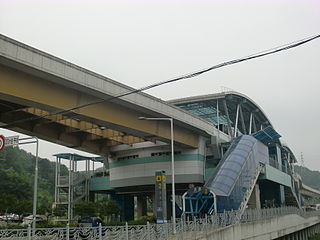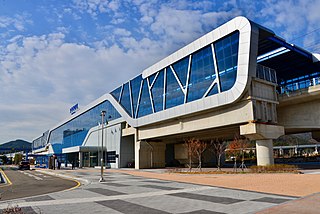
The National Institute of Fisheries Science , is a scientific body operated by the South Korean government, under the authority of the Ministry for Food, Agriculture, Forestry and Fisheries. It was first established in 1921. Subsidiary institutes operate in each of the major Korean fisheries.

Korea New Network (KNN) is the biggest regional free-to-air commercial broadcasting station based in Centum City, a high-tech media development complex within Haeundae in Busan, South Korea. KNN is affiliated with SBS. It was originally founded in April 1994 as Pusan Broadcasting Corporation (PSB). It had first begun its demo transmissions upon its establishment in April, and later on September 7 the same year it had begun its test transmissions, and then commenced its official broadcasts on May 14, 1995. As of 2011 its own programs make up to 35 percent of all programs.

Gijang County is a gun, or county, located between Haeundae-gu and Ulsan in northern Busan, South Korea.

Hynobius yangi, the Kori salamander, is a species of salamander endemic to southeastern South Korea. It is a lentic-breeding species similar to the Korean salamander but is distinguished by factors including tail shape and dorsal coloration. The species is known from the vicinity of the type locality in Gijang County in northeastern Busan and from the nearby Ulju County in western Ulsan.
Volleyball was one of the many sports which was held at the 2002 Asian Games in Busan, South Korea. All matches played at the Gijang Gymnasium.

Waeseong in Jukseong-ri, Gijang is located in Gijang-gun, Busan, South Korea. It is a stone fortress built by the Japanese general, Kuroda Nagamasa who was defending the area against the Korean Joseon army in about June 1593, during the second year of the Imjin War.
Cycling was contested at the 2002 Asian Games in Busan, South Korea. Road bicycle racing was held at the Road Cycle Race Stadium from September 30 to October 2, while track cycling was contested at Geumjeong Velodrome from October 4 to October 8 and mountain biking was contested at Gijang Mountain Bike Race Stadium from October 10 to October 13.
The men's cross-country competition at the 2002 Asian Games in Gijang County was held on 13 October at the Gijang Mountain Bike Race Stadium.
The women's cross-country competition at the 2002 Asian Games in Gijang County was held on 12 October at the Gijang Mountain Bike Race Stadium.
The men's downhill competition at the 2002 Asian Games in Gijang County was held on 10 October at the Gijang Mountain Bike Race Stadium.

Gochon Station is a station of the Busan Metro Line 4 in Cheolma-myeon, Gijang County, Busan, South Korea. This station name comes from Gochon-ri, Cheolma-myeon.

Anpyeong station is a station of the Busan Metro Line 4 in Cheolma-myeon, Gijang County, Busan, South Korea.

Gijang station is a railway station of the Donghae Line in Gijang-eup, Gijang County, Busan, South Korea.

Ilgwang Station is a railway station of the Donghae Line in Ilgwang-myeon, Gijang County, Busan, South Korea.

Jwacheon Station is a railway station of the Donghae Line in Jangan-eup, Gijang County, Busan, South Korea. The station is unrelated to the station of the same name of Busan Metro.

Wollae Station is a railway station of the Donghae Line in Jangan-eup, Gijang County, Busan, South Korea.
National Route 31 is a national highway in South Korea connects Gijang, Busan to Singosan, Anbyeon. Due to the separation of Korean peninsula, it de facto ends in Yanggu It established on 31 August 1971.
The 2016 Women's Baseball World Cup was the 7th edition of the WBSC Women's Baseball World Cup, the biennial international women's baseball world championship tournament. The competition was held in Gijang, South Korea from September 3 to September 11, 2016.
National Route 14 is a national highway in South Korea connects Geoje to Pohang. It established on 31 August 1971.

OSIRIA station (Korean: 오시리아역) is a railway station of the Donghae Line in Gijang-eup, Gijang County, Busan, South Korea.














